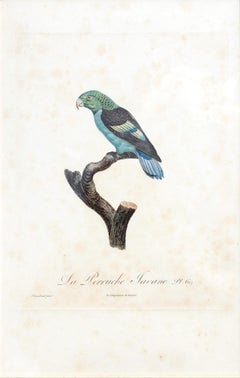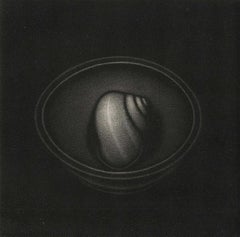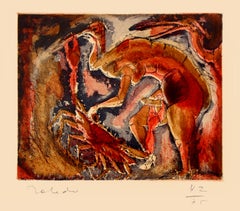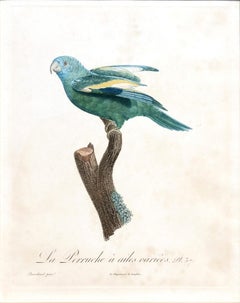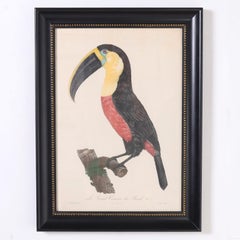Jacques Barraband Art
to
1
1
1
Overall Width
to
Overall Height
to
1
1
1
1
1
2
2
1
2
1
1
3
10,082
2,770
1,381
1,375
1
2
Artist: Jacques Barraband
[ Bird of Paradise] La Pie de paradise, vue par derriere, No.21
By Jacques Barraband
Located in Paonia, CO
[ Bird of Paradise] La Pie de paradise, vue par derriere , No.21, Paris 1801-1806 [Astrapia nigra]. Color-printed engraving with hand-coloring. French botanical and zoological illustrator Jacques Barraband (1767-1809) was known as one of the finest ornithological artists of his time .He is best known for his watercolors and engravings that were commissioned by François LeVaillant, French explorer, naturalist, zoological collector , noted ornithologist and author. Levaillant’s Histoire naturelle des perroquets (1801-05) and his Histoire naturelle des oiseaux de paradis (Birds of Paradise, 1801-06), both of which Barraband contributed to, are still considered some of the most beautiful bird books of all times because of their exceptional scientific accuracy, rich color and detail. The Astrapia nigra is a Bird of Paradise that inhabits the Vogelkop Peninsula of West Papua...
Category
Early 18th Century Other Art Style Jacques Barraband Art
Materials
Engraving
$5,200 Sale Price
20% Off
La Perruche Javane, Pl. 69
By Jacques Barraband
Located in Austin, TX
Artist: Jacques Barraband
Title: La Perruche Javane Pt 69
Year: 1801 - 1805
Medium: Engravings with Original Hand-Coloring
Sheet Size: 20" x 13.38"
About the Artist:
Jacques Barraba...
Category
Early 1800s Jacques Barraband Art
Materials
Archival Paper, Engraving
Related Items
Snail in a Bowl (Artist Proof inscribed to Fritz Eichenberg)
Located in New Orleans, LA
Leonard Merchant's mezzotint, "Snail in Cup" is inscribed for fellow artist, Fritz Eichenberg.
While a student at the Central School for Arts and Crafts in London, a young Leonard Marchant found an engraving rocker in a cupboard and proceeded to turn himself into a master of the painstaking art of mezzotinting.
Marchant, who has died in Shrewsbury aged 70, grew up in Simonstown, the Royal Navy's enclave in South Africa. Though his first job was as a parliamentary messenger, he taught himself to paint and, aged 19, was given a one-man show in Cape Town. Fired by this success, he left for England to study painting and, he claimed, to escape the stifling home atmosphere created by his Catholic mother and aunts. (His father was killed in the second world war.) Without contacts in London, he phoned Jacob Epstein, whose recommendation resulted in a grant to study briefly at the Central School. It was later, when studying full-time at the Central, that he saw the mezzotints of the Japanese master, Yozo Hamaguchi, in a London gallery. He was hooked.
Creating a mezzotint is tedious in the extreme. The copper plate must first be prepared with a "rocker" which roughens the surface. A plate may be "rocked" 30 or 40 times. The rough texture is then reduced with a burnisher and a scraper, allowing the print a range of tones from velvety black through the greys to white. Marchant's plates could be months in the making. But the technical demands were the least of his worries. In its 18th- and 19th-century heyday, mezzotint was solely a reproductive medium, for copying masters such as Reynolds and Turner. The development of photography rendered it unfashionable, and by the 1960s the technique, known as la manière anglaise, was a bygone medium.
Marchant, by now a teacher in printmaking at the Central, began to create original mezzotints with a colleague, Radavan Kraguly. A perfectionist, he seemed to revel in the straitjacket procedure. Perhaps it was the metaphor of bringing darkness out of light that appealed to this straight-talking, sometimes sombre, man, who would suddenly relax and light up like a gleaming hue on one of his prints. His work was of squares and triangles with the occasional cat, black and ominous, and carefully arranged still lifes, featuring plants, a seed pod, a pot he might have bought at auction to celebrate the sale of a print.
There were one-man shows, notably at the Bankside Gallery. He sold well at the Royal Academy summer exhibition, was a Florence Biennale prizewinner, spent a fellowship year at the British School in Rome, and was elected a Fellow of the Royal Society of Painter-Printmakers.
But making mezzotints was not a paying job. Marchant and his South African wife...
Category
1980s Modern Jacques Barraband Art
Materials
Mezzotint
$138 Sale Price
25% Off
H 5.88 in W 5.88 in
CANGREJO MANO LARGA
By Francisco Toledo
Located in New York, NY
paper: 22 x 15 in.
printed image: 4 3/4 x 6 in.
english translation: Long Hand Crab
Latin
Category
Late 20th Century Post-Modern Jacques Barraband Art
Materials
Archival Paper, Drypoint, Etching, Aquatint
Wine
By David Shrigley
Located in Manchester, GB
David Shrigley, Wine, 2021
Hand-signed and dated on the reverse
Edition 29 of 125
75 x 56 cm
Screenprint in colours
Private Collection UK
Category
2010s Contemporary Jacques Barraband Art
Materials
Screen
Tigre couché à l'entrée de son antre (Tiger Lying at the Entrance to its Lair)
By Eugène Delacroix
Located in Middletown, NY
Etching, drypoint, and roulette on watermarked Hallines cream laid paper, 3 3/4 x 5 7/8 inches (95 x 148 mm), full margins. A very good impression of this charming image, with all of...
Category
Early 19th Century Realist Jacques Barraband Art
Materials
Laid Paper, Drypoint, Etching
Echidna and Platypus, Australian animal monotreme antique engraving print
Located in Melbourne, Victoria
'Kloakentiere'
(Monotremes - echidna and platypus))
German wood-engraving, circa 1895.
240mm by 155mm (sheet)
Category
Late 19th Century Naturalistic Jacques Barraband Art
Materials
Engraving
$65
H 9.45 in W 6.11 in
The Celestial Hippocampus (Ed. 88/140)
Located in Dallas, TX
"The Scar by China Miéville is a novel which has been a part of my life for many years, and has travelled as my companion through since adolescence. I've attempted to depict the Avan...
Category
21st Century and Contemporary Surrealist Jacques Barraband Art
Materials
Screen
Le Millouinan /// Ornithology Martinet Bird Animal Art Duck Natural History
By François Nicolas Martinet
Located in Saint Augustine, FL
Artist: François-Nicolas Martinet (French, 1731-1800)
Title: "Le Millouinan" (Plate 1002)
Portfolio: Histoire Naturelle Des Oiseaux
*Signed by Martinet in the plate (printed signatur...
Category
1770s Old Masters Jacques Barraband Art
Materials
Watercolor, Laid Paper, Engraving, Intaglio
Cocoa plant, caterpillar, ..., Plate 26, Metamorphosis Insectorum Surinamensium
By Maria Sibylla Merian
Located in Middletown, NY
Metamorphosis Insectorum Surinamensium, Plate No. 26; Cocoa plant, caterpillar, pupa, and butterflies. The Netherlands: 1705. En...
Category
Early 18th Century Naturalistic Jacques Barraband Art
Materials
Watercolor, Engraving
Hermit Crabs, German animal antique underwater crustacean engraving print
Located in Melbourne, Victoria
'Einsiedlerkrebse'
(Hermit crabs)
German wood-engraving, circa 1895.
240mm by 155mm (sheet)
Category
Late 19th Century Naturalistic Jacques Barraband Art
Materials
Engraving
$50
H 9.45 in W 6.11 in
Mexican signed limited edition orginal print mezzotint 17.4x13.8 in.
By Fernando Aceves Humana
Located in Miami, FL
Fernando Aceves Humana (Mexico, 1969)
'Lo que nos trajeron', 2007
mezzotint on paper
17.4 x 13.8 in. (44 x 35 cm.)
Edition of 20
ID: ACE-101
Unframed
Category
Early 2000s Contemporary Jacques Barraband Art
Materials
Paper, Etching, Screen, Mezzotint
Eagle /// Antique Ornithology Bird Saverio Manetti Italian Watercolor Engraving
By Saverio Manetti
Located in Saint Augustine, FL
Artist: Saverio Manetti (Italian, 1723-1785)
Title: "Eagle" (Plate V - 5)
Portfolio: Storia Naturale Degli Uccelli (The Natural History of Birds)
Year: 1767-1776
Medium: Original Hand-Colored Engraving on watermarked laid paper
Limited edition: Unknown
Printer: Unknown
Publisher: heirs of Francesco Mouck (Vols. I-III), Gaetano Cambiagi (Vol. IV), Giuseppe Vanni (Vol. V), Florence, Italy
Reference: Ayer/Zimmer page 241; Fine Bird Books page 120; McGill/Wood, page 450; Nissen IVB No. 588
Sheet size: 16.75" x 14.5"
Platemark size: 13.63" x 10.88"
Condition: Some minor surface marks mainly in margins. In excellent condition with strong colors
Rare
Notes:
Provenance: private collection - Haarlem, Netherlands. Engraved and hand-colored by Italian artists Lorenzo Lorenzi (Active: 1750-1780) and Violante Vanni (1732-1776). Latin and Italian texts by Saverio Manetti. Comes from Manetti's monumental five volume "Storia Naturale Degli Uccelli (The Natural History of Birds)", (1767-1776), which consists of 600 hand-colored engravings. Unidentified watermark in very center of sheet. Comes with its accompanying information sheet.
Eagle is the common name for many large birds of prey of the family Accipitridae. Eagles belong to several groups of genera, some of which are closely related. Most of the 60 species of eagle are from Eurasia and Africa.
Manetti's extraordinary "Storia Naturale Degli Uccelli (The Natural History of Birds)", 1767-1776 was commissioned by Maria Luisa, the Grand Duchess of Tuscany. It is a massive 5 book volume set...
Category
1770s Old Masters Jacques Barraband Art
Materials
Watercolor, Engraving, Handmade Paper, Laid Paper, Intaglio
Thistle and Moths, plate no. 6, Metamorphosis Insectorum Surinamensium
By Maria Sibylla Merian
Located in Middletown, NY
Metamorphosis Insectorum Surinamensium, Plate No. 6; Thistle and Moths. The Netherlands: 1705. Engraving with hand coloring in w...
Category
Early 18th Century Naturalistic Jacques Barraband Art
Materials
Watercolor, Engraving
$5,300
H 12.88 in W 9.63 in
Previously Available Items
La Perruche a Ailes Variees Pt. 57
By Jacques Barraband
Located in Austin, TX
Title: La Perruche a ailes variees Pt. 57
From: Histoire Naturelle des Perroquets
Date: 1801 - 1805
Size: 14" x 21"
Medium: Engraving...
Category
Early 1800s Jacques Barraband Art
Materials
Archival Paper, Etching
Antique Hand Colored Engraving of a Toucan by Jacques Barraband
By Jacques Barraband
Located in Palm Beach, FL
Striking 19th century engraving of a toucan hand colored by artist and naturalist Jacques Barraband (1767-1809 ) first published in Paris 1801. Presented under glass in a lacquered w...
Category
Early 19th Century Other Art Style Jacques Barraband Art
Materials
Glass, Wood, Lacquer
H 26.5 in W 20 in D 1 in
L'Are Rauna (Blue and Yellow Macaw)
By Jacques Barraband
Located in New York, NY
Original engraving, drawn by Jacques Barraband, printed in color and finished by hand from "Histoire Naturelle des Perroquets" bu Fra...
Category
Early 1800s Jacques Barraband Art
Materials
Paper
BARRABAND. Two Birds of Paradise
By Jacques Barraband
Located in London, GB
Two stipple engravings, printed in colours and finished by hand, with fine, strong colour, framed and glazed.
[Published in Paris, 1806].
These are two plates from ‘Histoire Nature...
Category
Early 1800s Naturalistic Jacques Barraband Art
Materials
Engraving, Handmade Paper
Jacques Barraband, La Perruche à front jaune, mâle. Plate 34, 1805
By Jacques Barraband
Located in London, GB
Original stipple engraving, printed in colours and finished by hand, with strong colour. Framed and glazed, overall size: 40.3cm by 55.6cm.
From Levaillant's "Histoire Naturelle des Perroquets", which is considered the most comprehensive and complete catalogue on the subject.
This magnificent work includes some of the most lively and colorful bird illustrations ever created. They capture not only the defining characteristics of the species, but also the charming personality of the individual bird.
This exquisite monograph was written by Francois Levaillant, an adventurer and natural historian, who was one of the first to record sightings of Australian parrots. Barrband's skill was greatly esteemed and his name lent cachet to the sumptious work authored by Levaillant. Barraband's brilliantly colored engravings of exotic birds coupled with Levaillant's precise descriptions represent the height of realistic bird art.
Jacques Barraband achieved great artistic notoriety for his work at the Gobelin tapestry works, the Sevres porcelain factory, and the palace of St. Cloud before coming to work for the French naturalist Francois Levaillant in the early years of the nineteenth century. Barraband collaborated with Louis Bouquet...
Category
Early 19th Century Naturalistic Jacques Barraband Art
Materials
Engraving
H 21.89 in W 15.87 in D 0.08 in
Pair of Parrot Prints
By Jacques Barraband
Located in New York, NY
Pair of 2 original engravings, drawn by Jacques Barraband, printed in color and finished by hand from "Histoire Naturelle des Perroquets...
Category
Early 1800s Jacques Barraband Art
Materials
Paper
Set of 4 Green Parrot Prints
By Jacques Barraband
Located in New York, NY
Set of 4 original engravings, drawn by Jacques Barraband, printed in color and finished by hand from "Histoire Naturelle des Perroquets" bu Francois Levaillant. Paris, ca. 1801.
Pl. 111: Le Perroquet...
Category
Early 1800s Jacques Barraband Art
Materials
Paper
L'Amazone Tapire en jaune (Amazon Yellow Parrot).
By Jacques Barraband
Located in New York, NY
Original engravings, drawn by Jacques Barraband, printed in color and finished by hand from "Histoire Naturelle des Perroquets" bu Fr...
Category
Early 1800s Jacques Barraband Art
Materials
Paper
Variete du Perroquet a Tete Grise - Plate 118.
By Jacques Barraband
Located in London, GB
Stipple engraving, printed in colours and finished by hand, with fine, strong colour, trimmed to just outside plate-mark, otherwise a fine copy with clean, strong colours. Dimensions: 340 by 255mm. (13.5 by 10 inches). Langlois, Paris, [1805].
From Levaillant's "Histoire Naturelle des Perroquets...
Category
Jacques Barraband Art
Jacques Barraband art for sale on 1stDibs.
Find a wide variety of authentic Jacques Barraband art available for sale on 1stDibs. You can also browse by medium to find art by Jacques Barraband in archival paper, engraving, paper and more. Not every interior allows for large Jacques Barraband art, so small editions measuring 14 inches across are available. Customers who are interested in this artist might also find the work of Jean Louis Prévost, Henri Edmond Cross, and Louis Moe. Jacques Barraband art prices can differ depending upon medium, time period and other attributes. On 1stDibs, the price for these items starts at $2,225 and tops out at $5,200, while the average work can sell for $3,150.
![jacques bird [ Bird of Paradise] La Pie de paradise, vue par derriere, No.21](https://a.1stdibscdn.com/jacques-barraband-prints-works-on-paper--bird-of-paradise-la-pie-de-paradise-vue-par-derriere-no21-for-sale/a_7803/1543778408303/Bird_of_Paradise_master.jpg?width=240)
